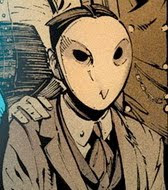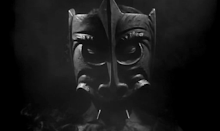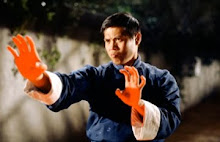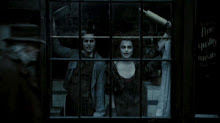
The Shining is not my favorite Stanley Kubrick film. Infact it’s probably my least favorite Stanley Kubrick film. The instance where his style and material simply didn’t mesh.
The reason’s pretty simple, I’ve just never been able to separate the film from book. I’m a big Stephen King fan. King is always going to have a special place in my heart, he was after all my first "favorite" author, the one who taught me to love and seek out an author's voice. Ever since I snuck into the adult section of the library on a fourth grade field trip and grabbed The Dead Zone, I've been a loyal fan. And The Shining is quiet possibly King’s best work.
The Shining as a novel is a terrifyingly human horror story. Jack Torrance is arguably King's greatest creation. In the novel Jack Torrance is a good man, but one who has been given a long hard look on multiple occasions of exactly what he's capable of. Yet somehow he’s managed to pick up the pieces, and life is just starting to reward him for it. His wife and child are starting to trust him again, his career might finally pick up...
And then he has to go to that fucking hotel.
The way it works the way every room, every task, ever whisper exploits the still fresh cracks in Jack until he just completely falls apart is terrifying and terrible to behold. You see a man who is desperately trying to hold it together, who knows what'll happen when he backslides. And then he does.
But even then Torrance is still in there, and what happens at the climax is haunting.
It's great, a fantastic piece of characterization and story telling. Like I said arguably King's best. A very human monster as terrifying as he is pitiful.
So of course the first thing Kubrick did was go "Naw fuck all that."
My problem with Kubrick’s Shining is that, there are plenty of scares in but no tragedy. Nicholson is just being "Wacky Jack" from there very beginning. There's no downfall, no good man destroyed. Just Nicholson going from "Raving Looney" to slightly crazier. There’s never a sense for one second that The Torrances have ever functioned as a loving family, so the destruction of the unit means nothing. While Danny in the book is a kid struggling with a power he doesn’t understand, and the revelation of who “Tony” is turns out to be quite poignant, in the movie he’s just a weird little kid who talks to his finger. And while Shelly Duvall does a fine job looking exhausted and terrified, she doesn’t bring a whole lot else to the table. In the book Wendy is an intelligent and strong woman every bit Jack’s equal. With the mousy Duvall in the lead there’s a real strange sense of “How the hell did these two get together?” It’s hard to imagine her and Jack having so much as conversation, let alone a marriage together. It doesn’t help that Nicholson looks about twice her age through the entire film.
There’s that same strange stiltedness to almost every conversation between the living in The Shining. It’s almost like one of Lynch’s REALLY weird movies like Lost Highway or Inland Empire. It’s almost like everyone is speaking in code. For example in the opening when Jack and and the hotel’s manager Ullman discuss the job at hand, Ullman tells Jack the store of Grady going crazy and killing his family. Jack’s response is to tell Ullman not to worry his wife love’s horror movies.
Wait…What the fuck?
Imagine that conversation in real life for a second.
“A madman murdered his wife and children!”
“Ooh Spooky!”
In terms of style it's magnificent. In terms of humanity There's simply nothing there. (And I know that's a charge often used against Kubrick, but I'd like to point out that this is the only movie where that accusation rings true as a detrement for me. While a certain detachment is needed to study the uppercrust of 18th century Europe in Barry Lyndon, the bizarre underground circles of Manhattan in Eyes Wide Shut, or the dystopian future of Clockwork Orange, the style doesn’t really work when it’s applied to a working class family in the eighties).
However, I decided that this time I really was going to give The Shining the benefit of the doubt. Put the book out of my mind, and see the movie with fresh eyes and to give the movie the benefit of the doubt I brought my good friend Herb McSmoky Weed along to the screening. Sadly the results where pretty much the same, if a little more so. I came away from the movie with more impressed by what Kubrick was going for, and yet more disenchanted then ever with how he did it. Still I saw enough interesting wrinkles this time to movie The Shining past Killer’s Kiss. Keep reaching for the stars.
Let’s start off with the good, The Shining’s style particularly when shooting the supernatural, is pretty freaking amazing. Kubrick shoots the various ghosts who show up, in away that is almost a hyper reality. Always shot in Kubrick’s trademark “frames within frames” (The two little girls first in a doorframe then in a hallway, Lloyd between the mirrors of the bar, The Old Lady in the bathtub, Grady between the urinals, the final shot of Jack in a literal frame within a frame, etc. etc. etc.) In scenes like the iconic “two little girls” shot, or the one where Wendy witnesses a man in a dogsuit giving a blow job, the feeling is that they are the intruders, the impermanent ones, after all as Grady puts it, they “have always been there.” It’s the Torrances who are where they don’t belong.
However, the best haunting scenes are the ones in Barroom’s Bathroom. While a bit less flashy then the film’s better known scares, the bathroom scene is the only one where the movie comes close to recreating the bone deep terror of the book. One of Kubrick’s little signatures, was to have some of the worst things happen in the bathroom, man at his most savage at the place where he is least dignified. And once you see the bathroom Kubrick is using…

… Damn you know some bad shit is about to happen in there. The scene that follows takes a lot of the stuff that Kubrick has been doing and really makes it work. The long takes and pauses in the conversation, the way the conversations seem to almost be in code and makes it all work for one chilling sequence. Bizarre N bomb dropping aside (come on Stanley did they have to be racist ghosts?)
The film technique keeps you on edge. It just keeps doing things that are a little off, from how they are normally done. It’s constant use of fades for example give it a strange sense of inevitability. A cut suggests a jump, two unrelated things that become related and associated. It’s more or less the building block of filmic language, and the missing space between the two cuts, suggest some amount of free will in how the characters got to that place. The fade doesn’t allow that luxury, one scene becomes the next which fades into the next and into the next, there is no possible scene except the one that follows it.
Another little thing that I found odd this time, though I’m willing to concede that it might be a simple trick of my DVD’s mix, or my speakers, is the fact that a lot of Kubrick’s orchestral score doesn’t seem to be score at all but source music. Particularly in some of the scenes with Nicholson, the music seems to be coming directly from the room. Though we’re never shown a record player or anything of the like. It’s just one of those things, that makes you go “Weird.” Like the idea that Torrance thought it’d be a good plan to bring a shitload of Bartok LPs to an isolated hotel where everyone would be on edge.
But then again that is the type of character that Nicholson is playing. What the man lacks in pathos and nuisance he makes up for in pure crazy. Of course that’s the whole problem, from scene one he’s just playing wacky jack. Even in his “normal” scenes he seems on edge, it would be a surprise if he DIDN’T end up killing his family.
Still this time out I did have more appreciation for Nicholson’s performance. It’s almost Kabuki. It’s a rare scene where he wears more then one expression, it’s like before every sequence he’s affixed a Jack Nicholson mask to face, and convey’s the character through motion alone.
Unfortunately if anything my antipathy for Duval and whoever the hell the little kid was only grew. Still even this adds some interesting shades to the story. Duval is so bowled under by Nicholson that the film almost becomes a feminist horror movie, where marriage=loss of identity=death.
The Shining also loses steam in it’s somehow acclaimed ending. After the famed “Here’s Johnny” scene the movie just kinda sorta falls apart. Jack chases after his son, though he never gets close enough to be a threat, yelling. While Wendy stumble around the hotel seeing things that really aren’t that scary. Eventually they leave. And then Kubrick shows a picture.
The End.
The Shining as an adaptation is terrible, as entertainment it’s flawed and as a work of art it’s frustrating. But damned if I won’t keep coming back to, Kubrick’s put too much into it to ever have it be dismissed.





































































































2 comments:
The Shining is my fourth favourite Kubrick film, but unlike the top three it's kept out of my favourites from amongst all directors, and my problem with it is largely the same as yours: the lack of moral complexity in the characters. I wonder though, why this isn't a problem for A Clockwork Orange? it's a question I pose to myself (since it's one of my favourite films), but also to you, since you seem to like it or at least uphold it as a good film, from what I've read elsewhere on your blog. Perhaps you can give expression to the difference there.
That's a vaild question Fidelio.
I think my answer would be that A Clock Work Orange is more blatantly a fable. So the broader characters don't come off as strange.
Post a Comment